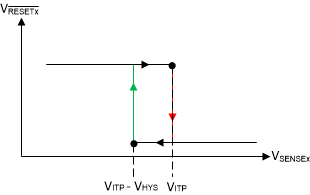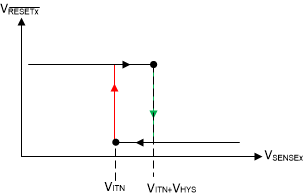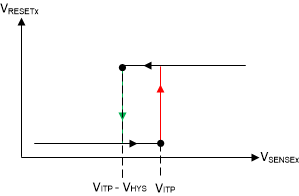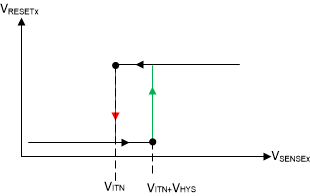JAJSKP3E August 2020 – August 2023 TPS38-Q1
PRODUCTION DATA
- 1
- 1 特長
- 2 アプリケーション
- 3 概要
- 4 Revision History
- 5 Device Comparison
- 6 Pin Configuration and Functions
- 7 Specifications
-
8 Detailed Description
- 8.1 Overview
- 8.2 Functional Block Diagram
- 8.3 Feature Description
- 8.4 Device Functional Modes
- 9 Application and Implementation
- 10Device and Documentation Support
パッケージ・オプション
メカニカル・データ(パッケージ|ピン)
サーマルパッド・メカニカル・データ
- DSK|10
発注情報
8.3.2.1 SENSE Hysteresis
 Figure 8-4 Hysteresis (Overvoltage
Active-Low)
Figure 8-4 Hysteresis (Overvoltage
Active-Low) Figure 8-6 Hysteresis (Undervoltage
Active-High)
Figure 8-6 Hysteresis (Undervoltage
Active-High) Figure 8-5 Hysteresis (Overvoltage
Active-High)
Figure 8-5 Hysteresis (Overvoltage
Active-High) Figure 8-7 Hysteresis (Undervoltage
Active-Low)
Figure 8-7 Hysteresis (Undervoltage
Active-Low)| TARGET | DEVICE ACTUAL HYSTERESIS OPTION | ||
|---|---|---|---|
| DETECT THRESHOLD | TOPOLOGY | RELEASE VOLTAGE (V) | |
| 18.0 V | Overvoltage | 17.5 V | -3% |
| 18.0 V | Overvoltage | 16.0 V | -11% |
| 17.0 V | Overvoltage | 16.5 V | -3% |
| 16.0 V | Overvoltage | 15.0 V | -6% |
| 15.0 V | Overvoltage | 14.0 V | -7% |
| 6.0 V | Undervoltage | 6.5 V | 0.5 V |
| 5.5 V | Undervoltage | 6 V | 0.5 V |
| 8 V | Undervoltage | 9 V | 1 V |
| 5 V | Undervoltage | 7.5 V | 2.5 V |
Table 8-1 shows a sample of hysteresis and voltage options for the TPS38-Q1. For threshold voltages ranging from 2.7 V to 8 V, one option is to select a fixed hysteresis value ranging from 0.5 V to 2.5 V in increments of 0.5 V. Additionally, a second option can be selected where the hysteresis value is a percentage of the threshold voltage. The percentage of voltage hysteresis ranges from 2% to 13%.
Knowing the amount of hysteresis voltage,
the release voltage for the undervoltage (UV) channel is
(VITN(UV) + VHYS) and for the overvoltage (OV) channel is
(VITP(OV) - VHYS). For a visual understanding of the UV and OV
release voltage, see Figure 7-2 and Figure 7-3 . The accuracy of the release voltage, or stated in the Section 7.5 as Hysteresis Accuracy is ±1.5%. Expanding what is shown in Table 8-1, below are a few voltage hysteresis examples that include the hysteresis accuracy:
Undervoltage (UV) Channel
VITN = 0.8 V
Voltage Hysteresis (VHYS) = 5% = 40 mV
Hysteresis Accuracy = ±1.5% = 39.4 mV or 40.6 mV
Release Voltage = VITN + VHYS = 839.4 mV to 840.6 mV
Overvoltage (OV) Channel
VITP = 8 V
Voltage Hysteresis (VHYS) = 2 V
Hysteresis Accuracy = ±1.5% = 1.97 V or 2.03 V
Release Voltage = VITP − VHYS = 5.97 V to 6.03V